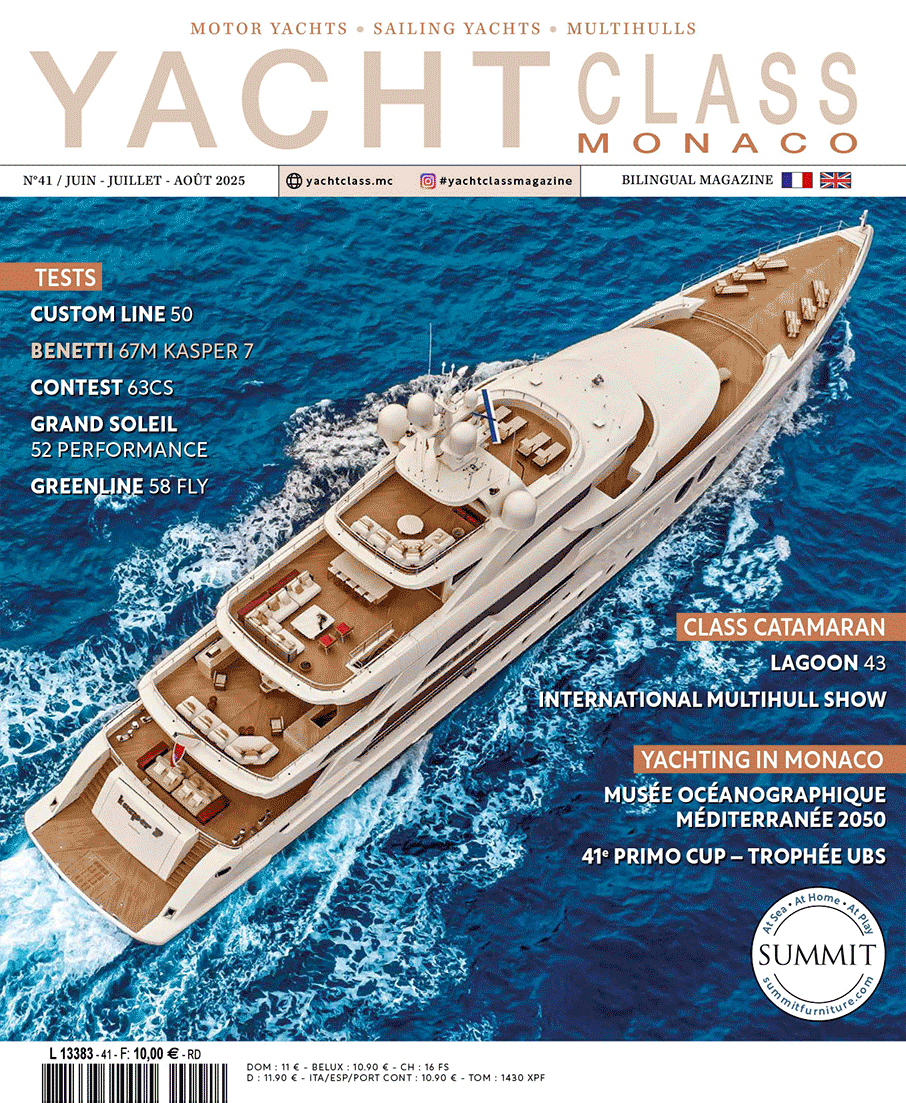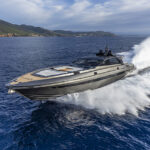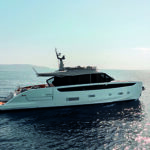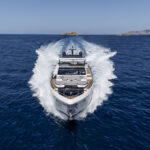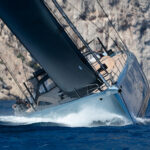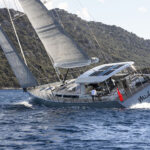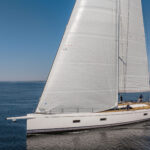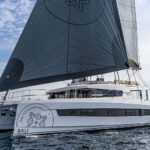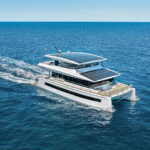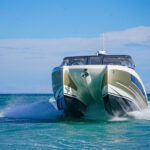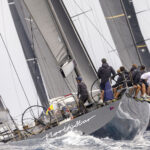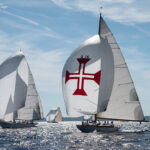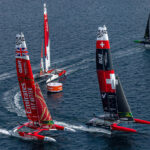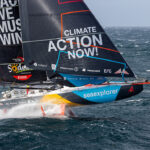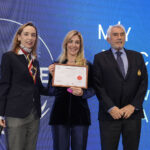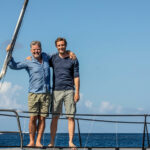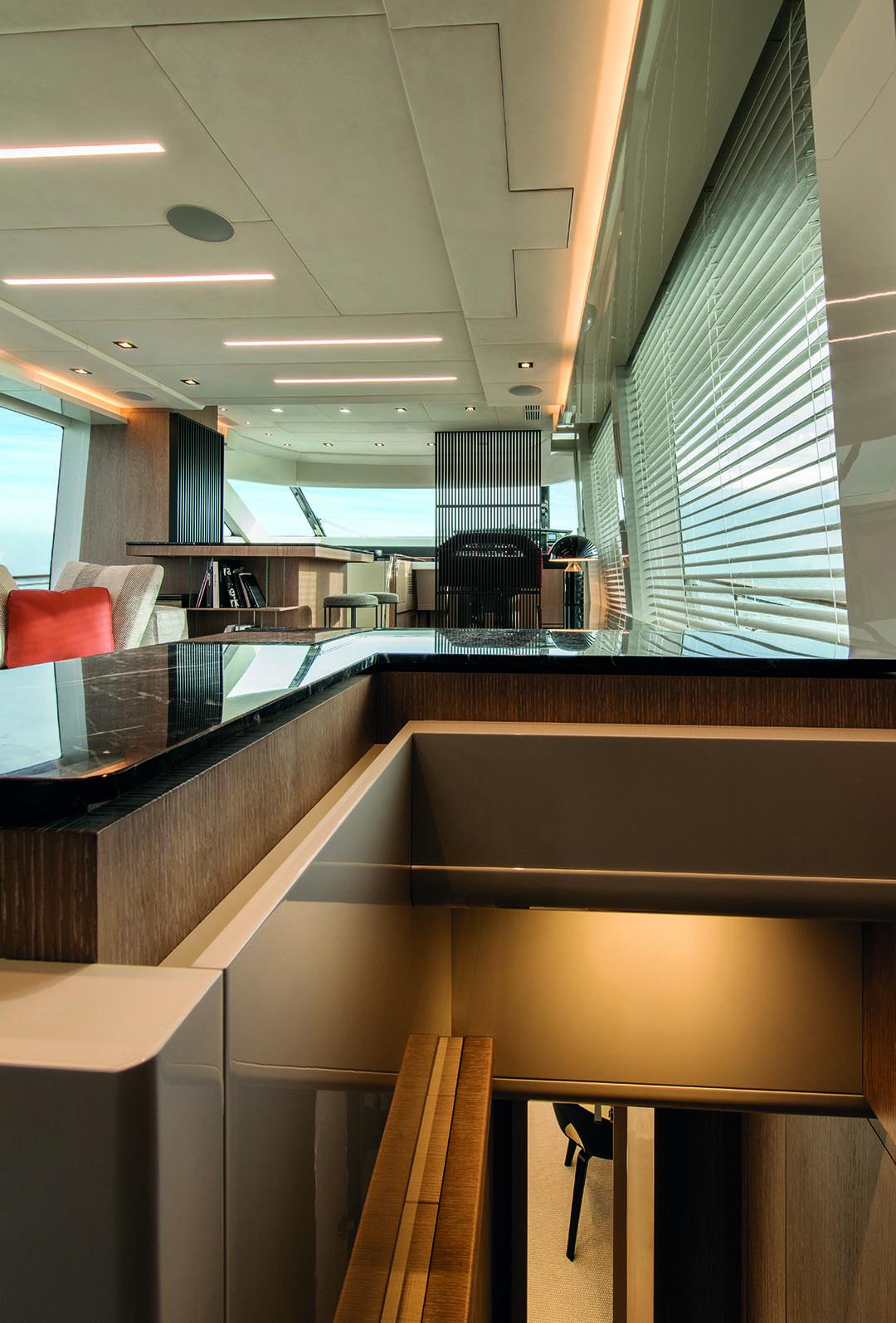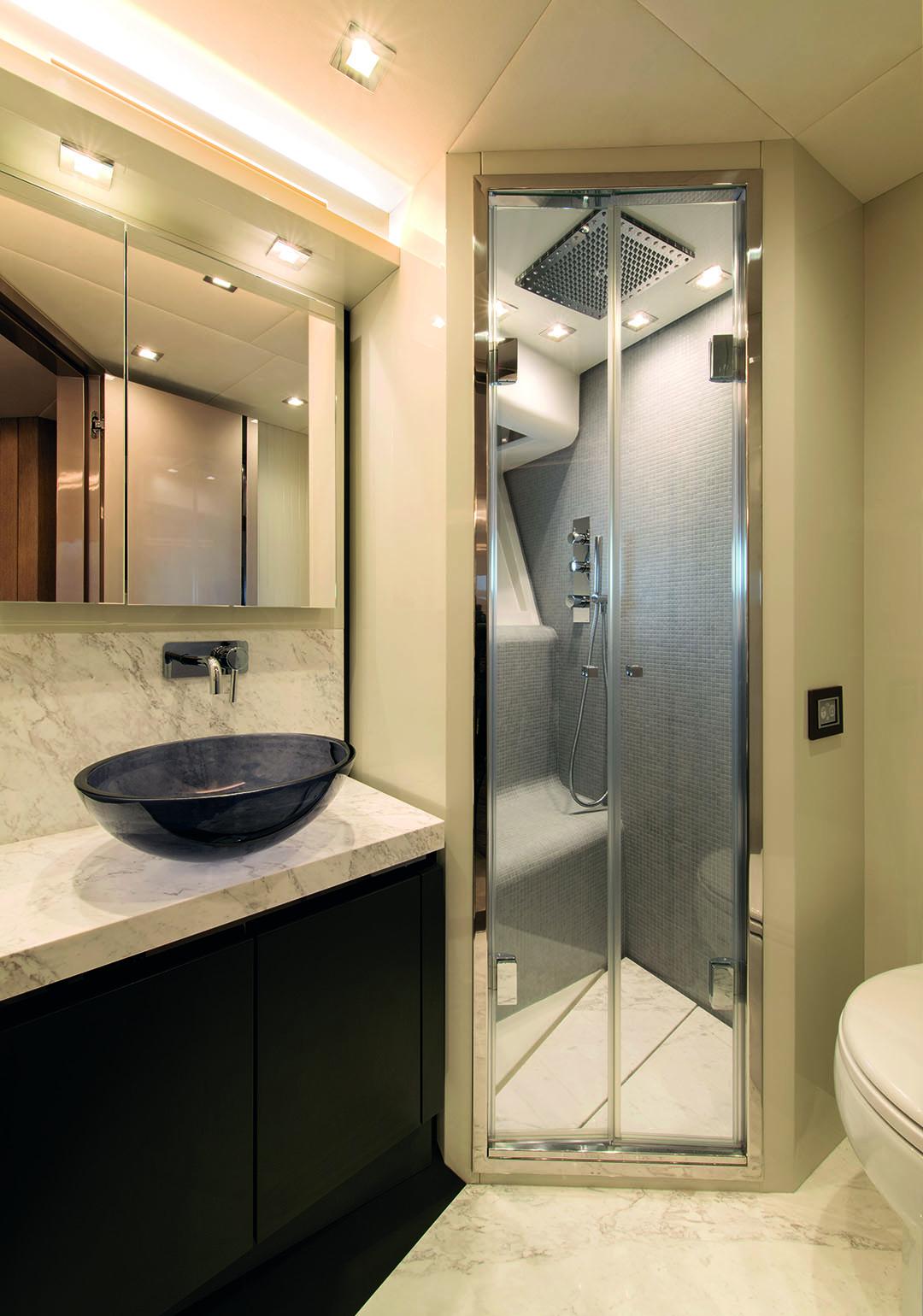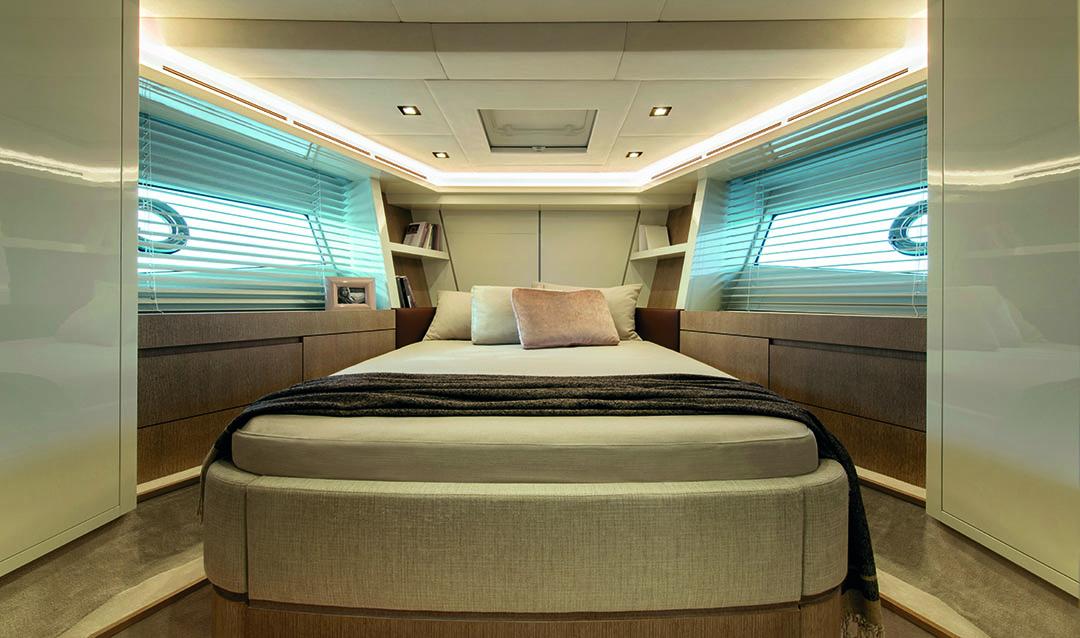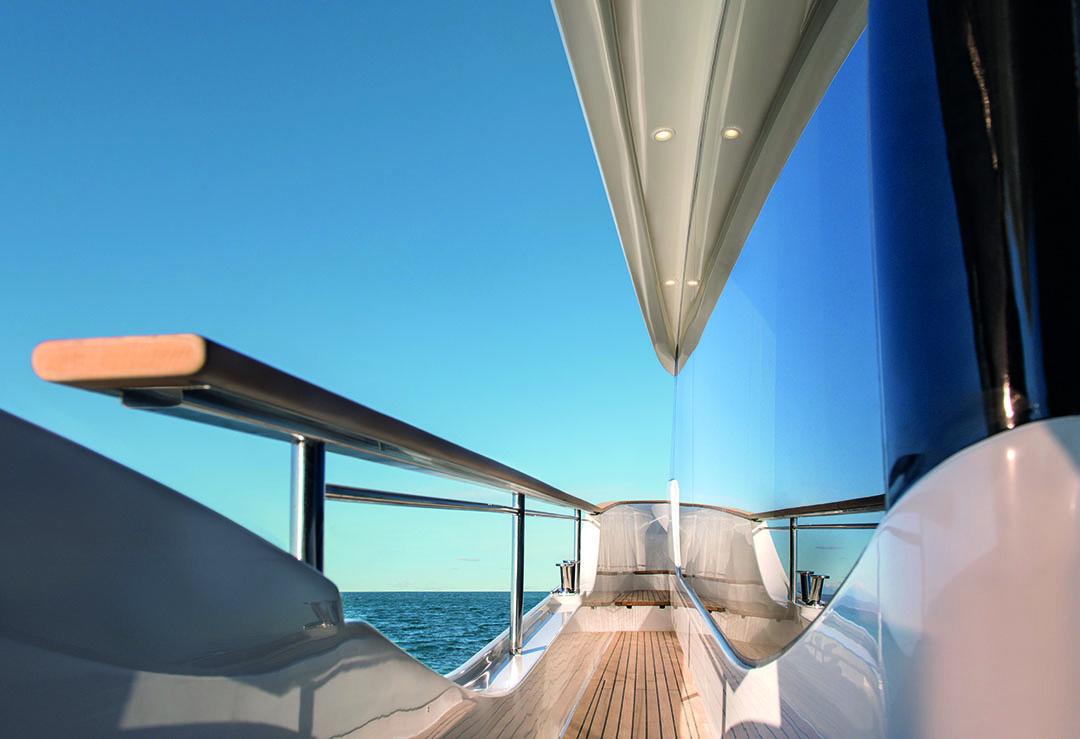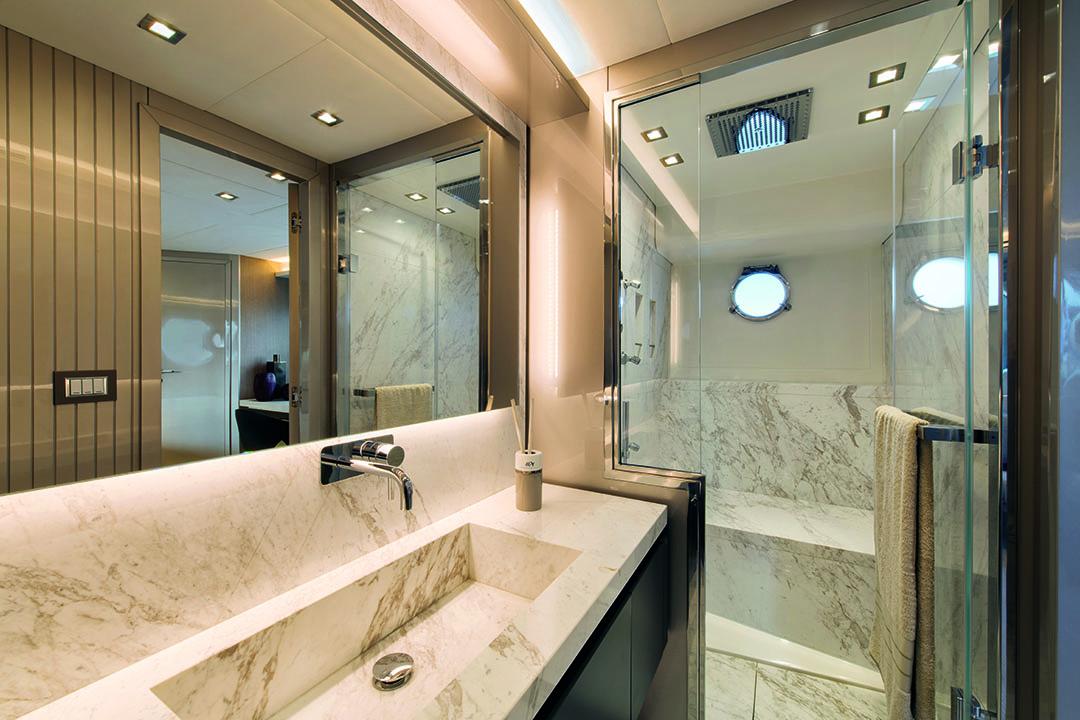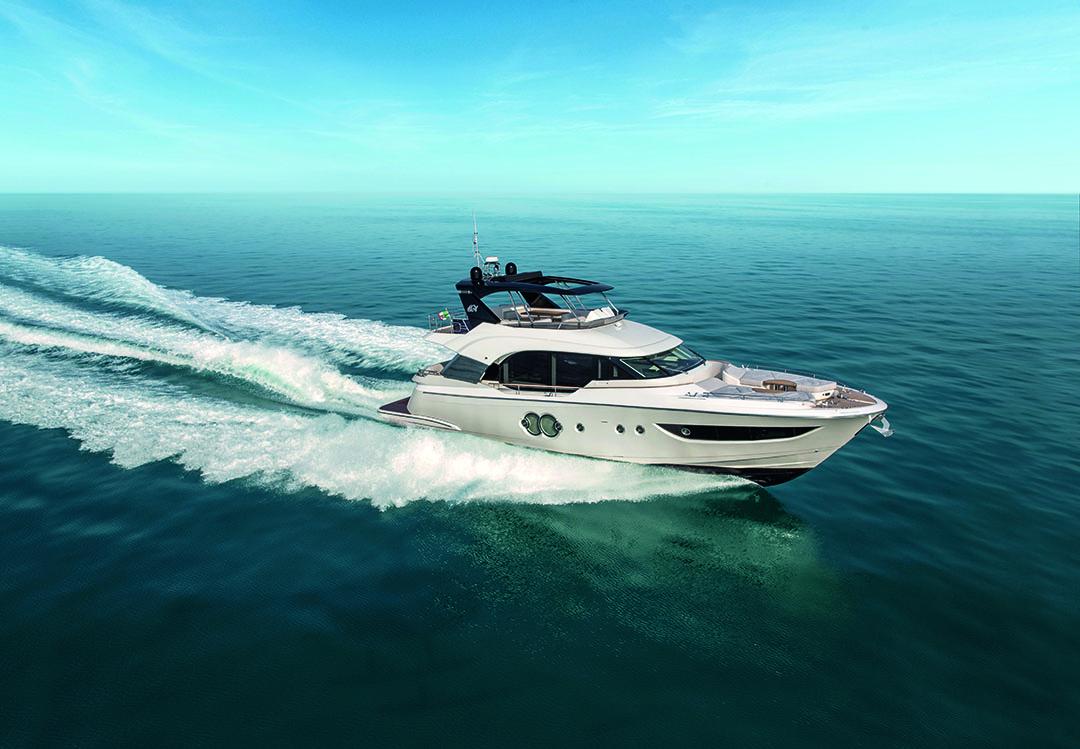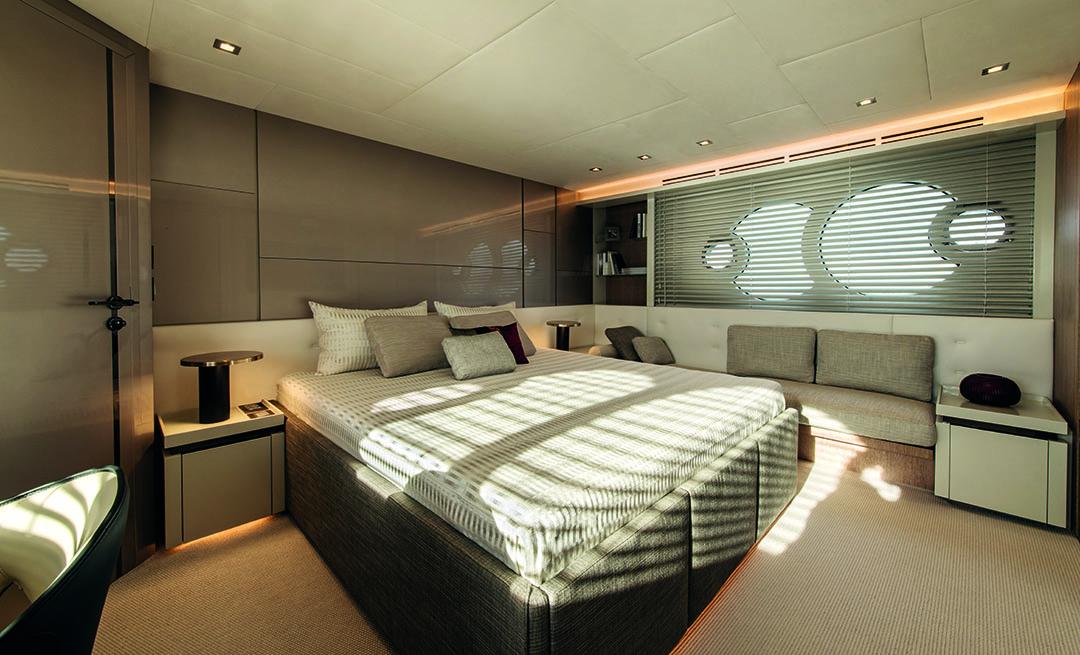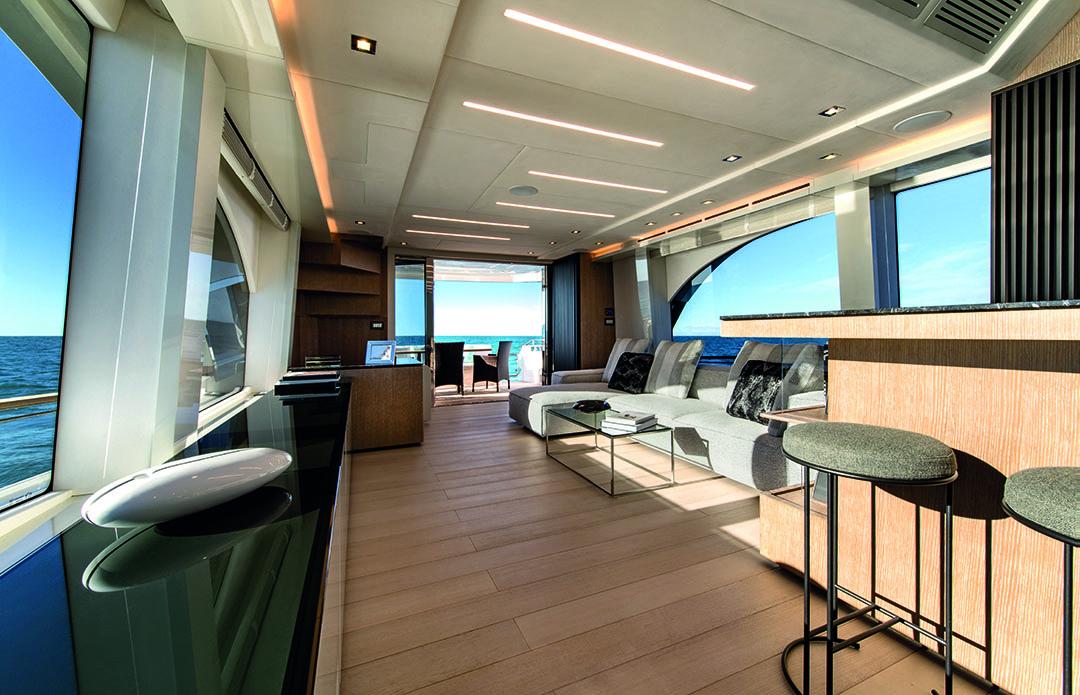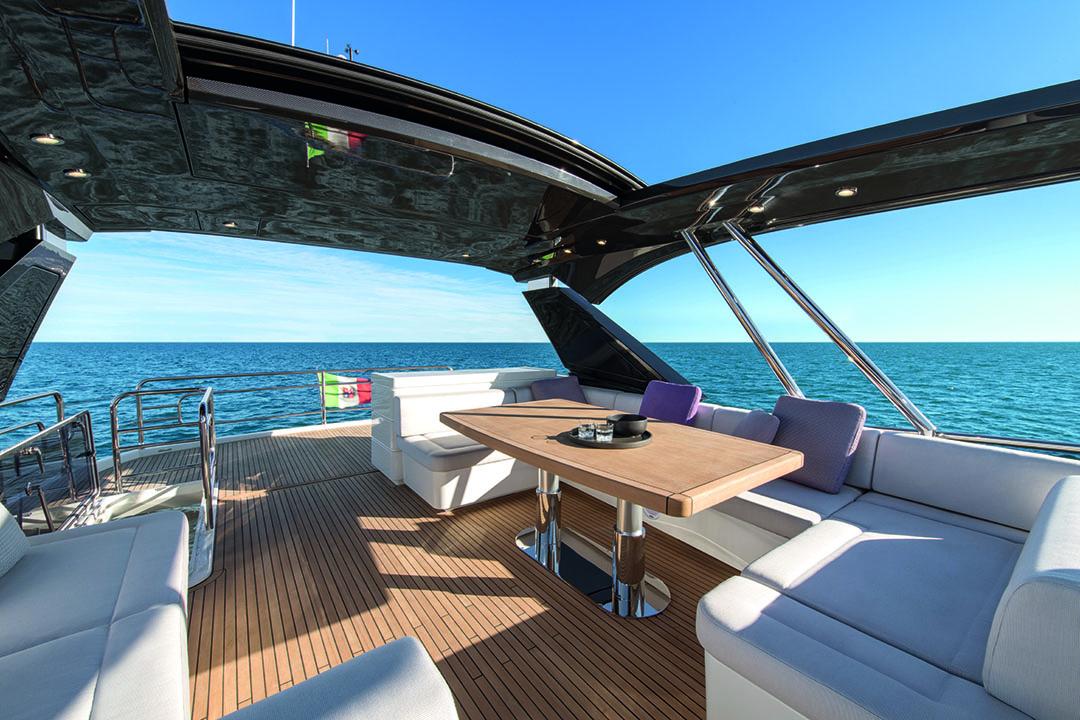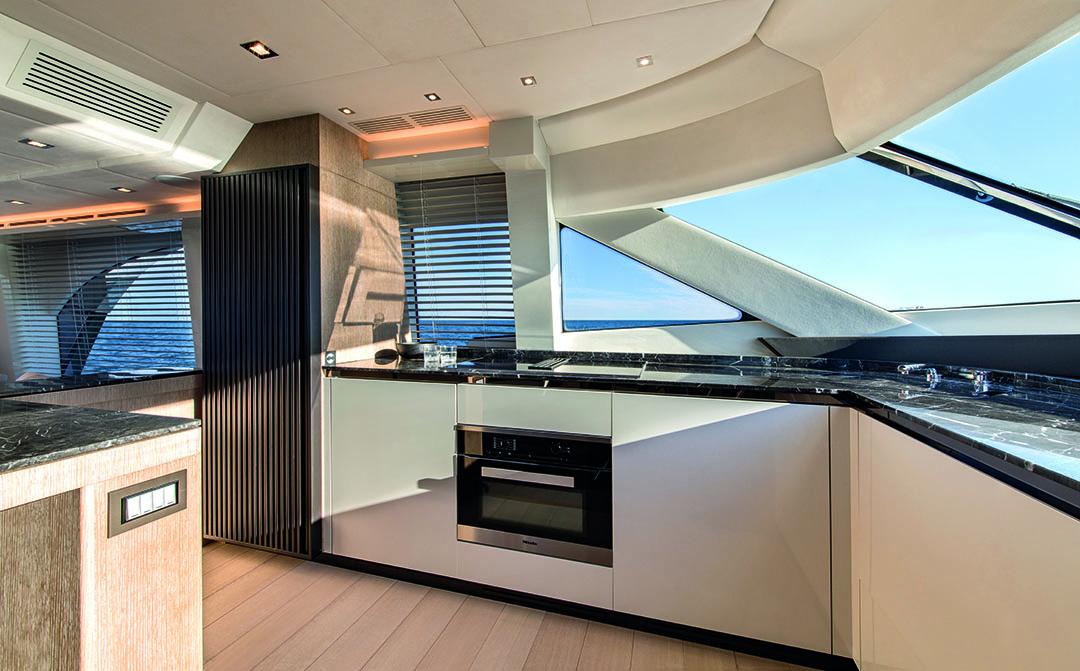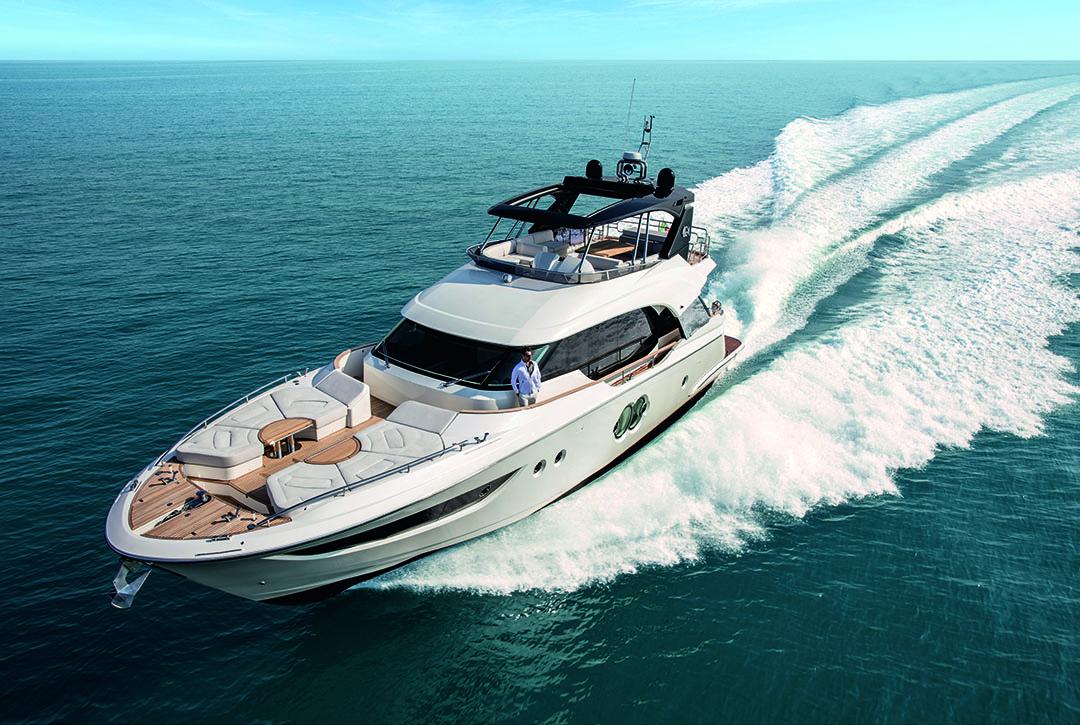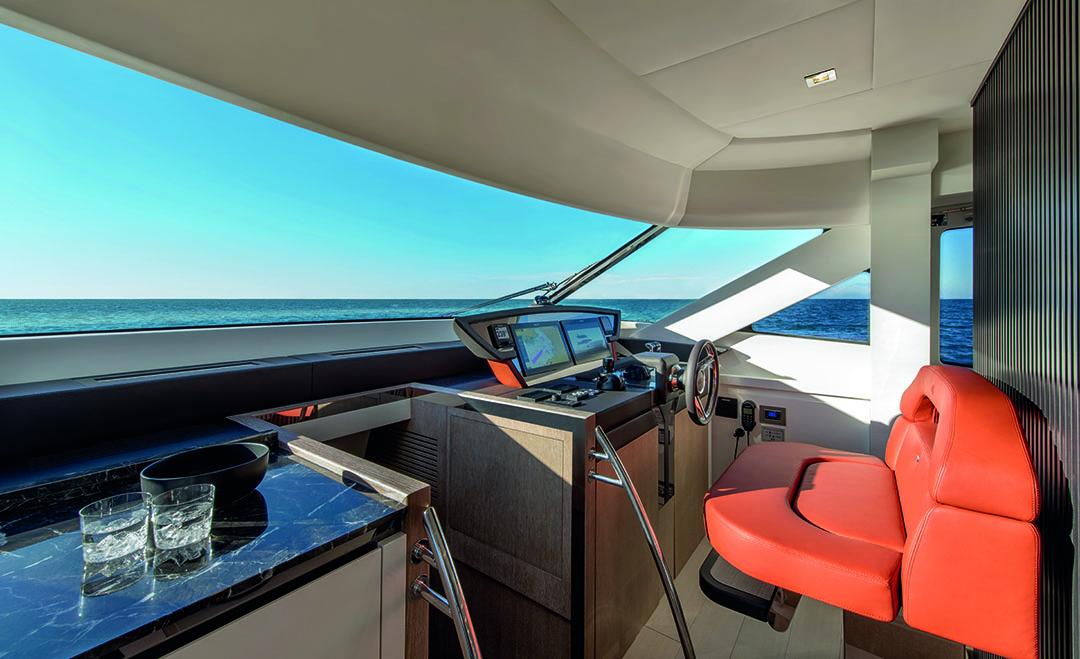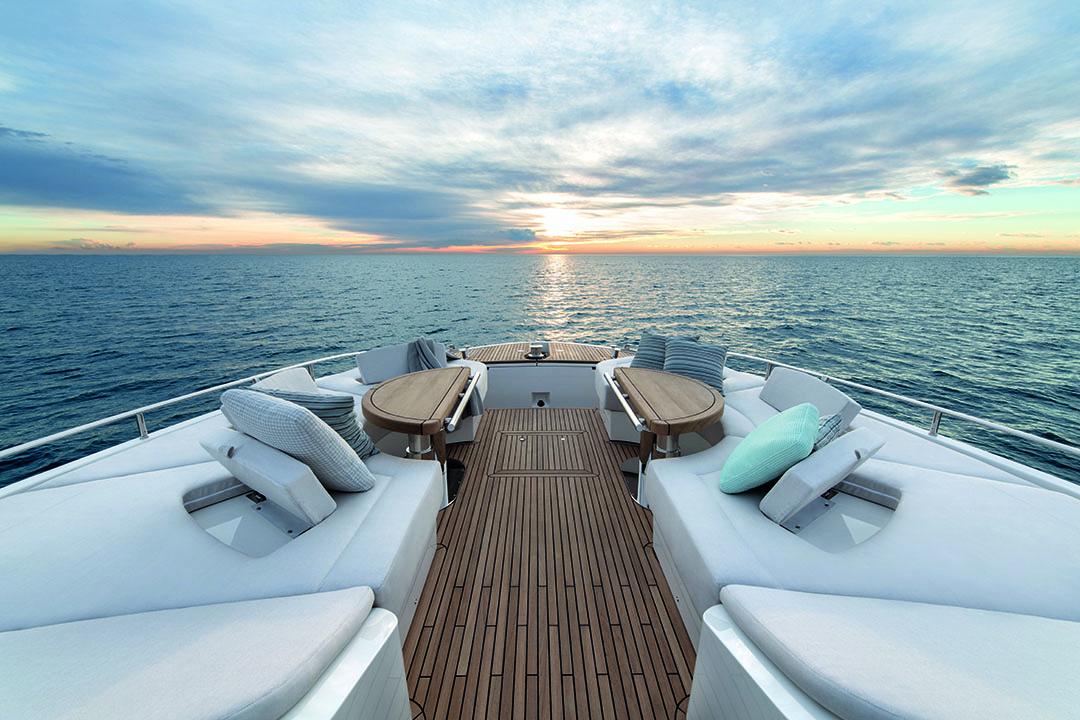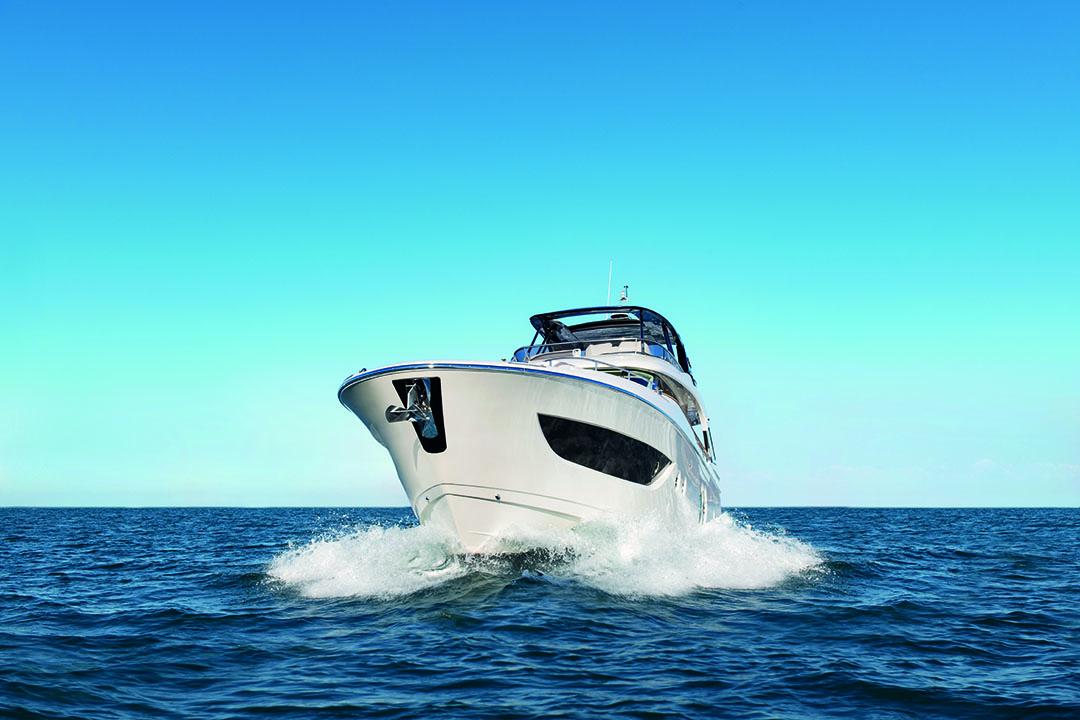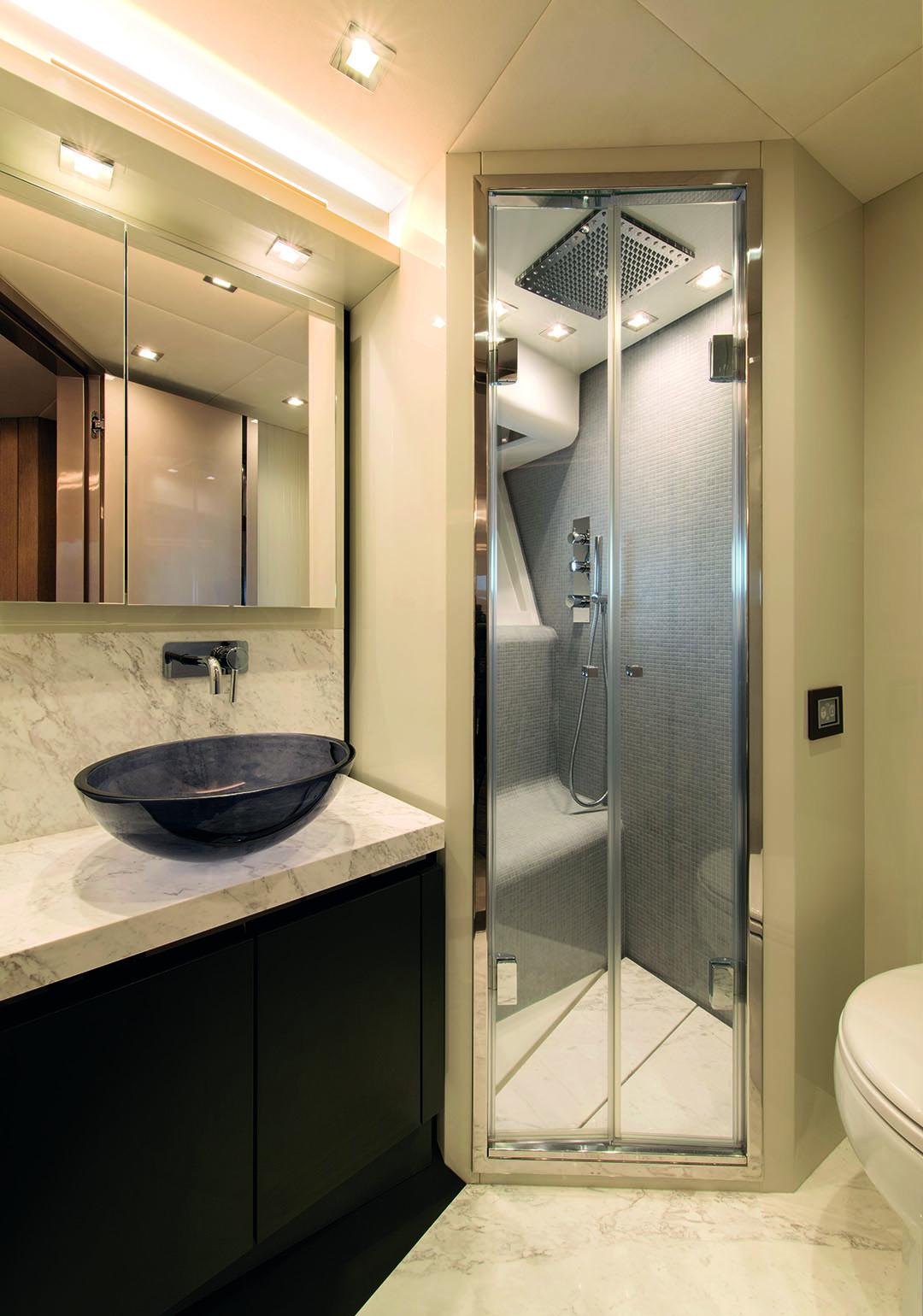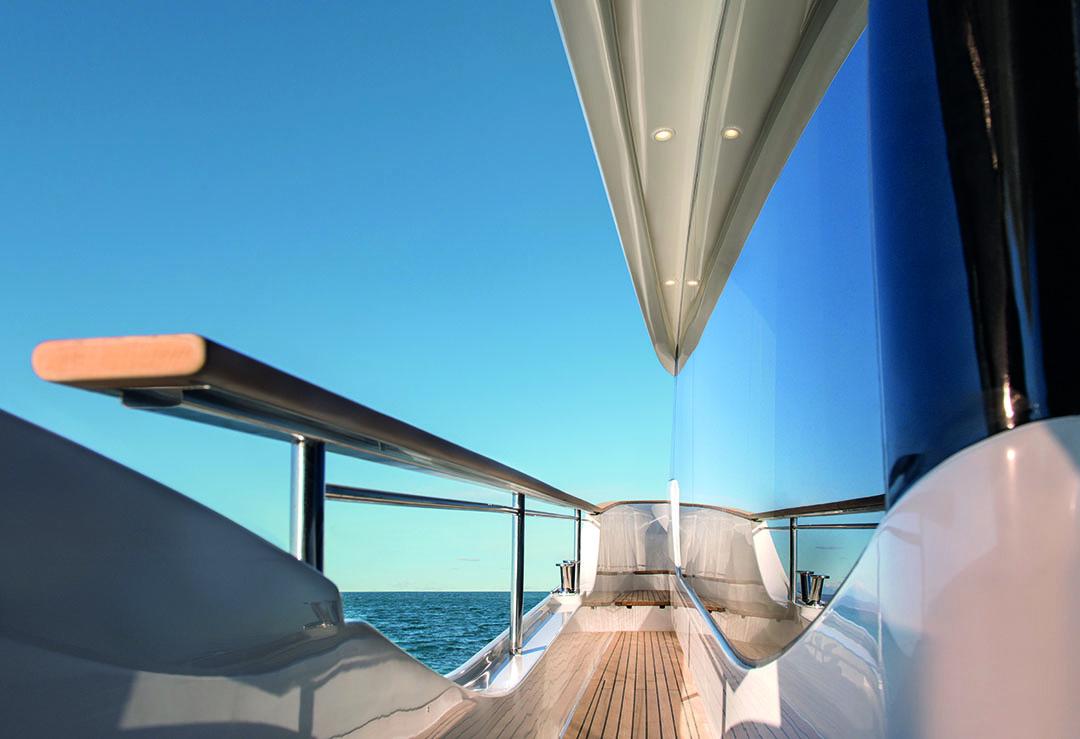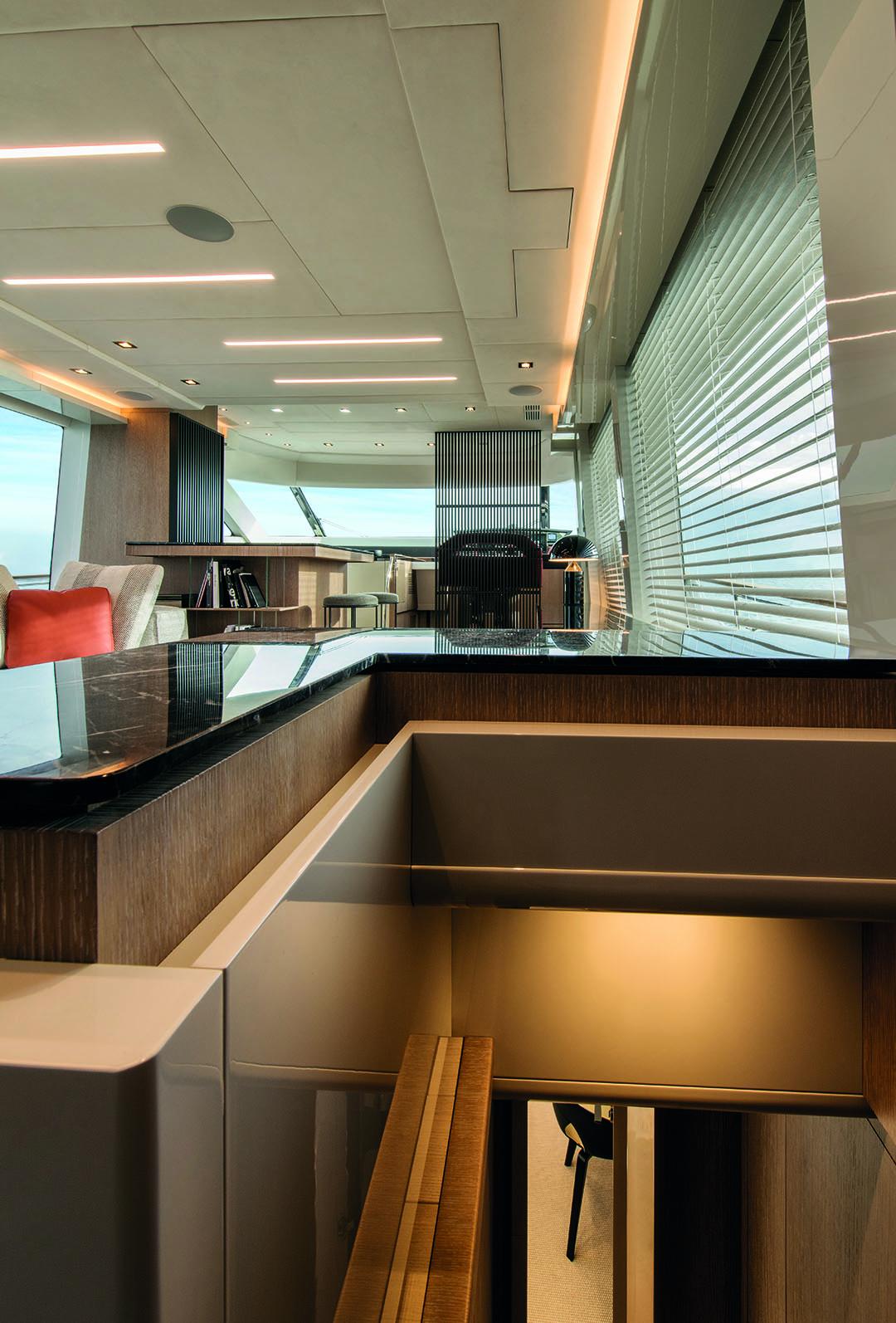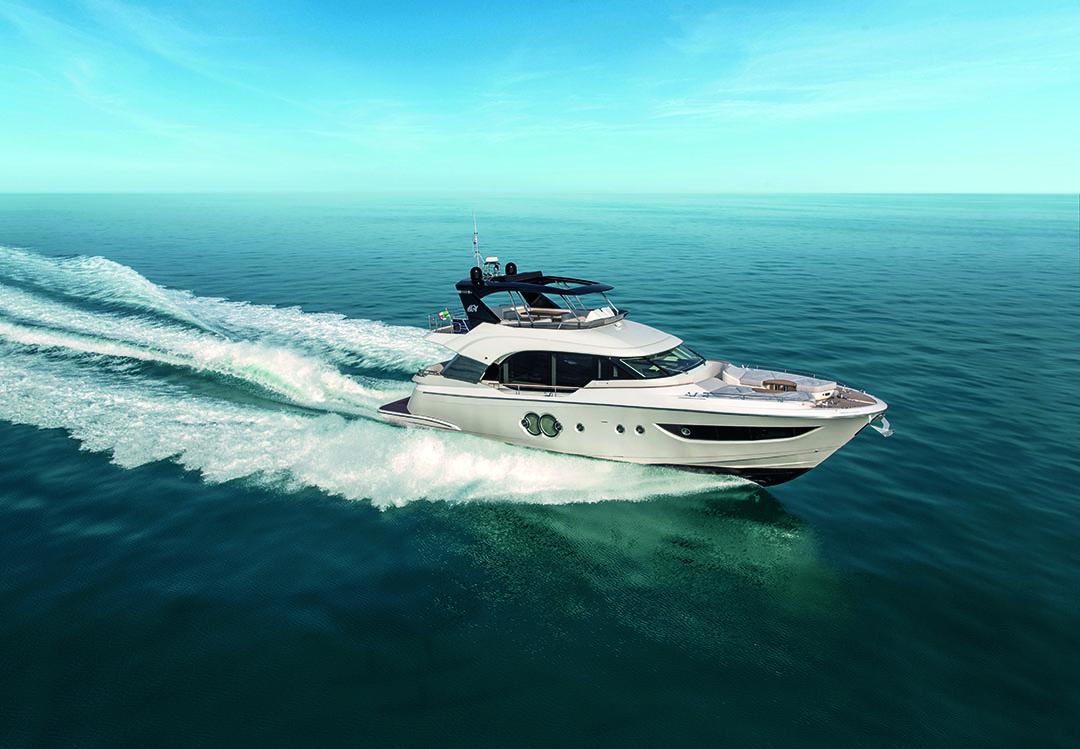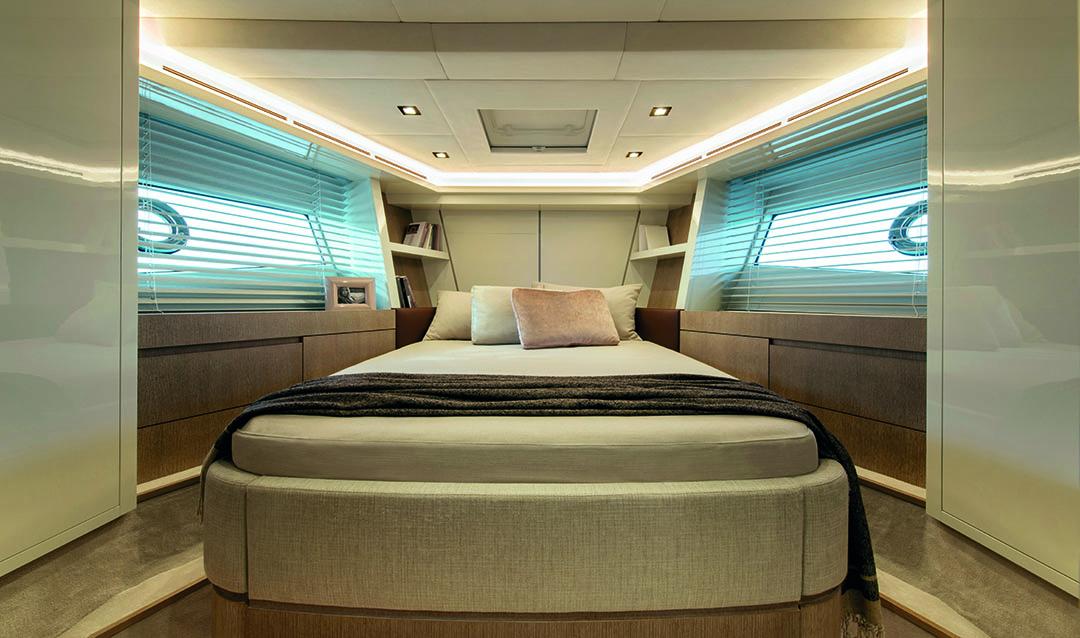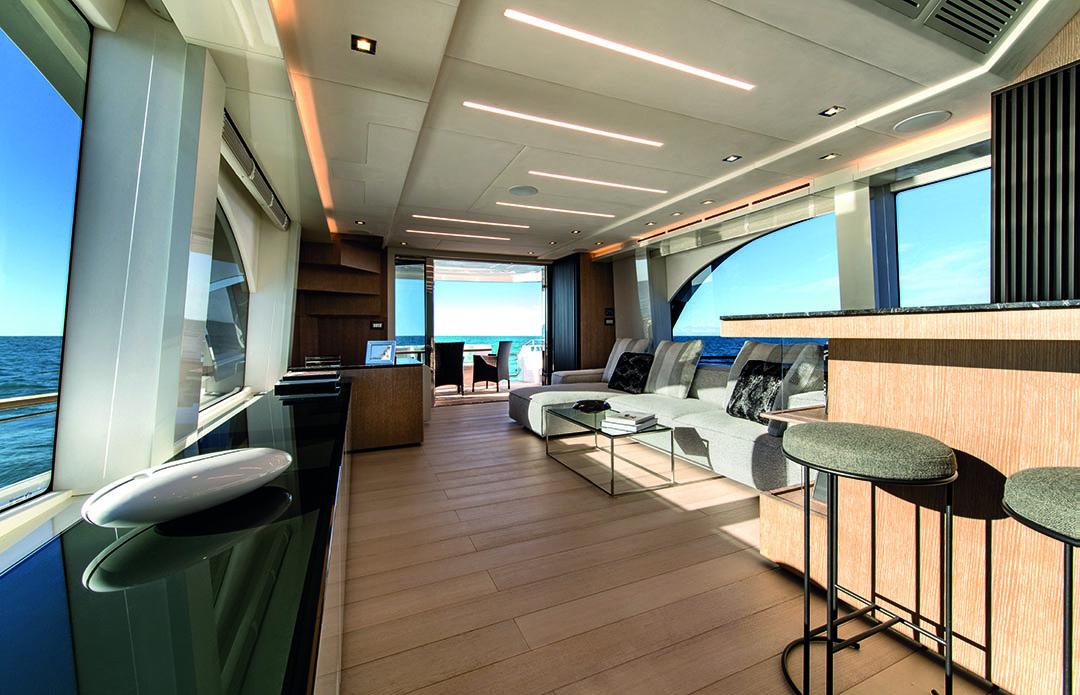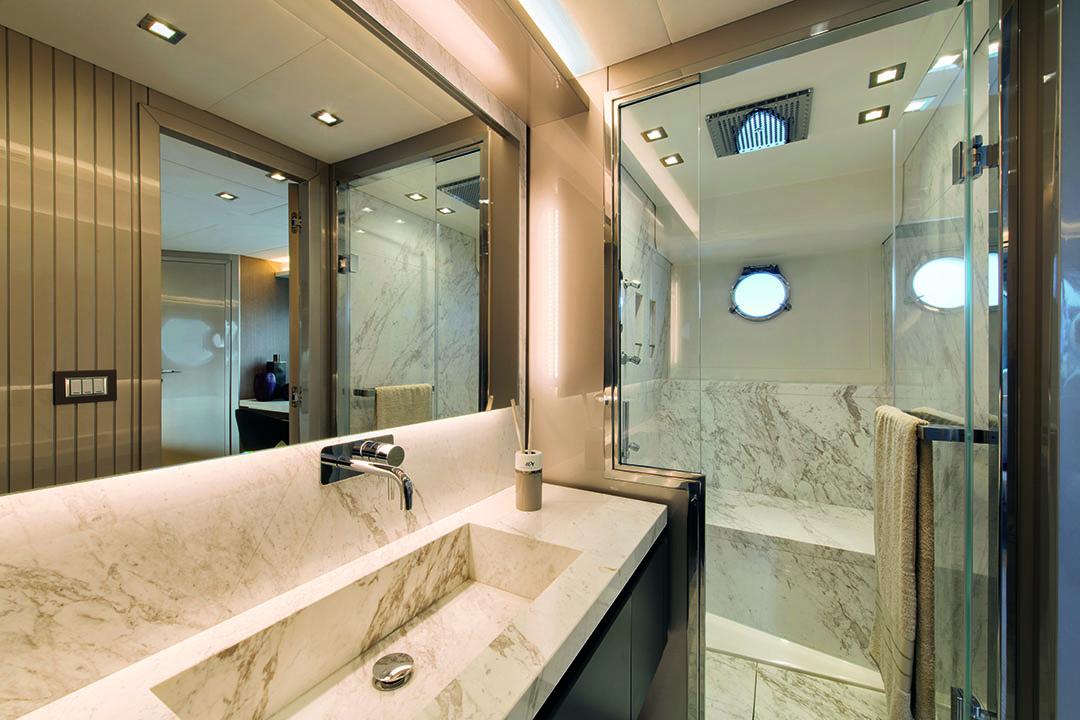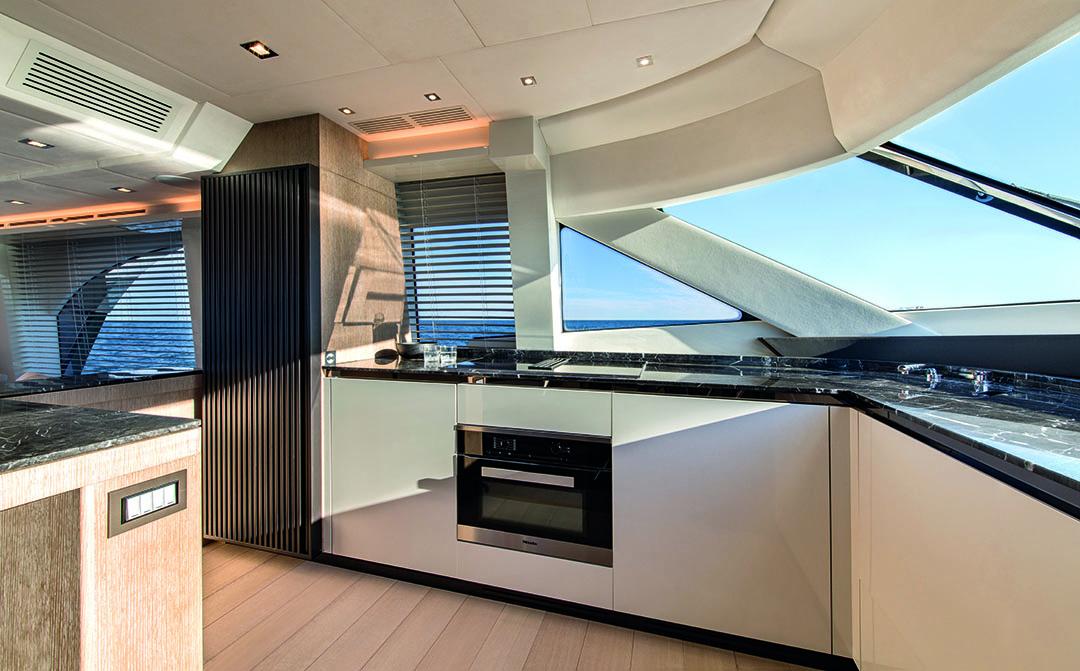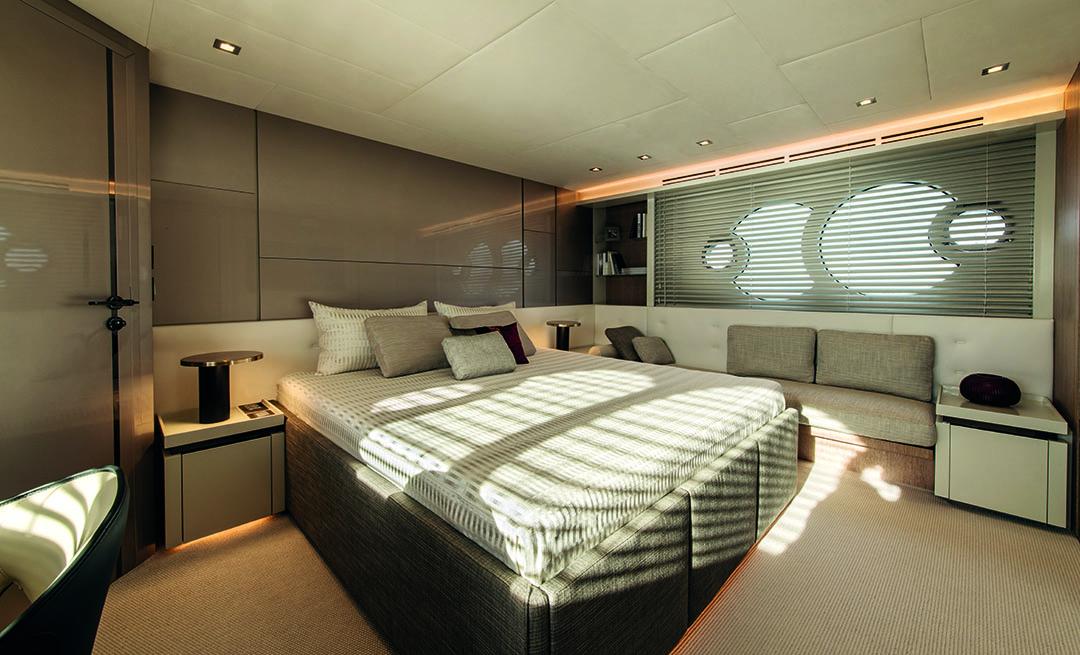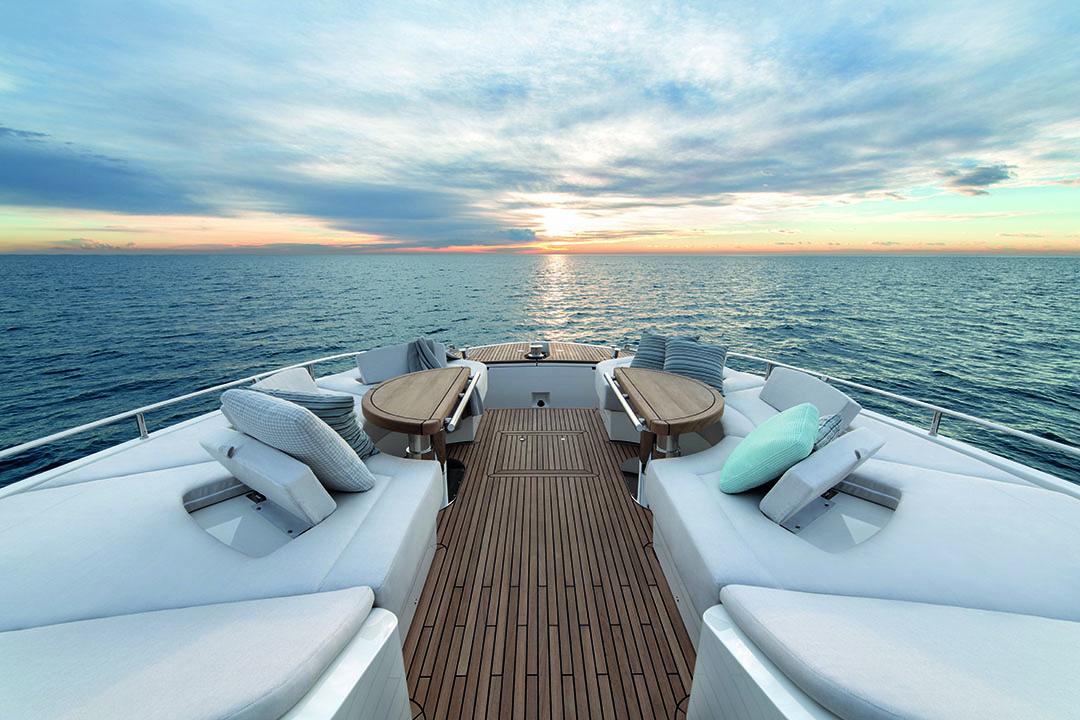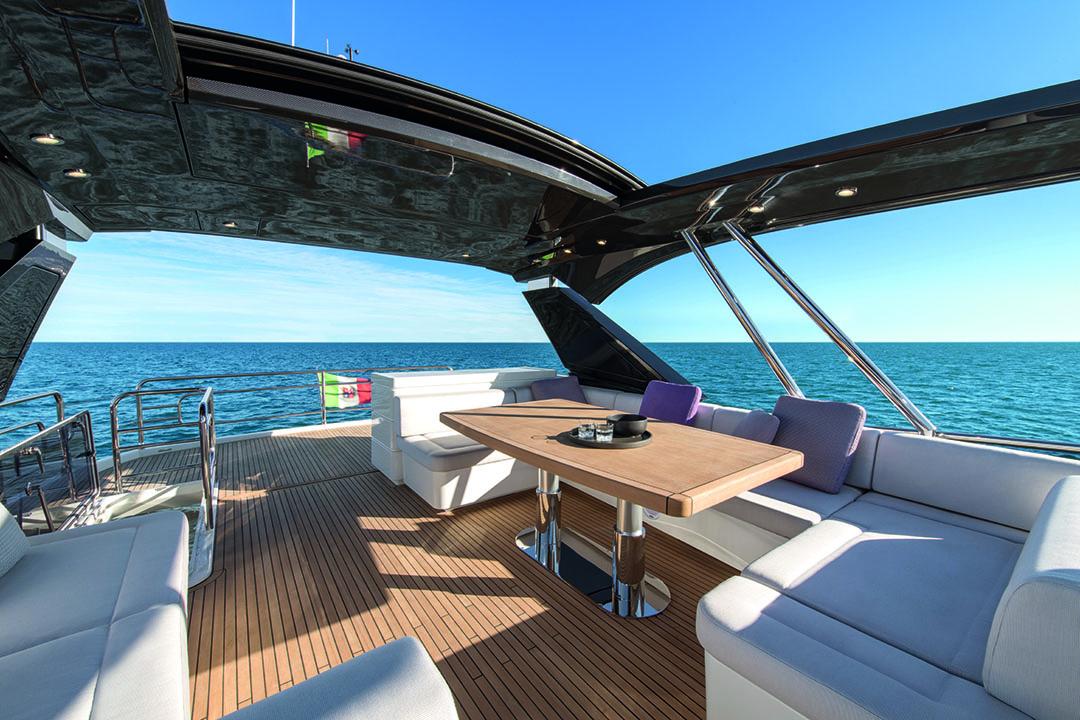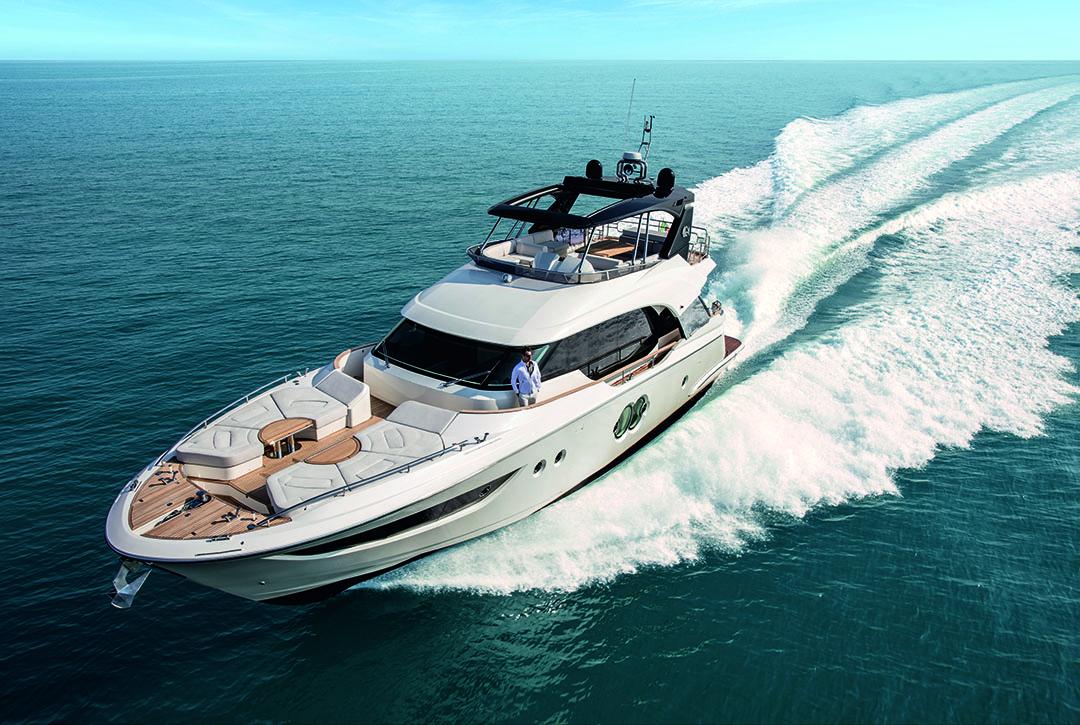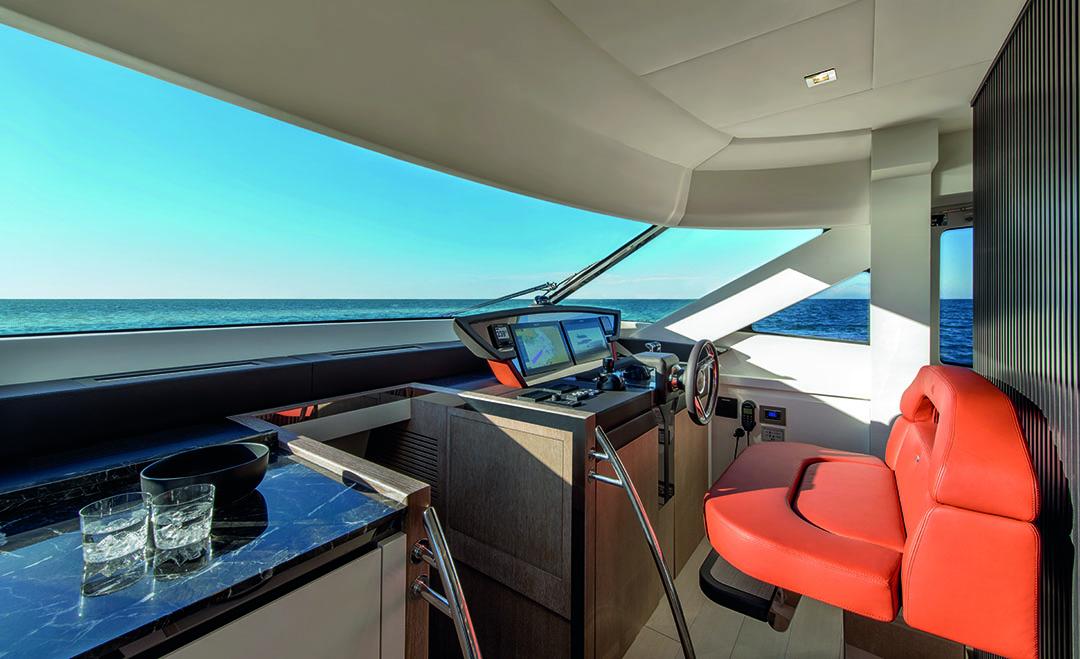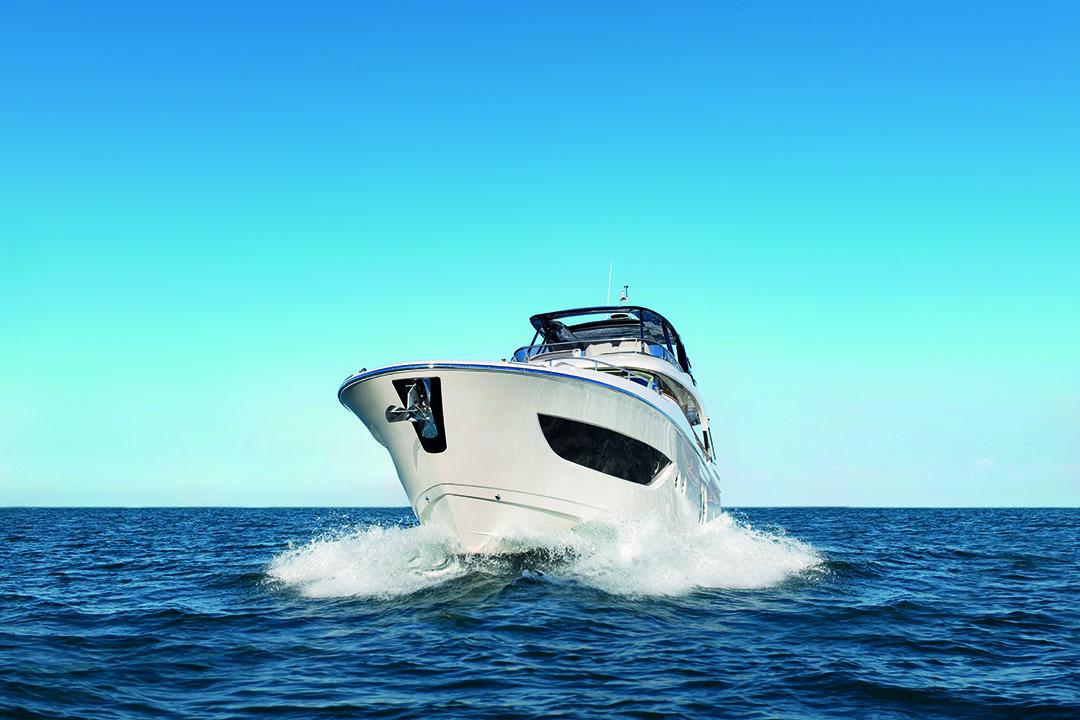Presentation
Yacht Class n°17 (june-july-august 2019)
Monte Carlo Yachts – Beneteau Group
This brand-new addition to the MCY range takes over from its eponymous predecessor. Among the major evolutions, an increased habitability, enlarged glass surfaces and an even more spacious new flybridge. You will want to extend your stay on board….
Written by: Philippe Leblond – Photos: All rights reserved
“What we do with Monte Carlo Yachts is the opposite of the market trends” immediately explained Dan Lenard, inseparable from his associate Carlo Nuvolari, the two famous designers at the head of the Venetian studio named after them, who work exclusively for Monte Carlo Yachts in this market segment. “Most of our competitors intend to revolutionize design, while we develop our style step by step so as not to lose our bearings. Our new models do not make our previous creations outdated. We want to be compared to Porsche, Rolex, Hermès ou Ray Ban. Long-term reference brands that do not forget to evolve.” In fact, no one can say Monte Carlo Yachts has no personality. Only a decade after its creation, the brand has made a name for itself. Thanks, of course, to a general silhouette that Dan Lenard defines as halfway between a yacht and an American sportfishing, with a high and flared bow, but also to the deck and flybridge lines falling away towards the stern. A style that gives the new MCY a sporty profile.
A much more spacious flybridge
This new 70 foot, which replaces the 2013 model, largely mirrors the style of her predecessor. Starting with the sports line mentioned above, but also the Portuguese bridge. Yet some elements have been revised, starting with an increased living space, thanks to a compacted technical compartment (hosting the fuel tank) which allowed to gain a metre in length inside for the cabins. She also boasts a larger flybridge (an additional 20% according to the yard’s) thanks partly to its conventional arch replacing the central support, plus an improved sea view obtained by larger glass surfaces, in particular in the forward VIP cabin. The pleasant foredeck saloon is still roughly the same. This recreational area is accessible from the cockpit via walkways. These could have been more generous in width and their bulwarks are only mid-thigh height in their central part. Cautious is thus required in navigation in beam seas. The foredeck is an invitation to relax on this lounge with a breathtaking sea view. It should also be noted that there is no handrail safeguarding the bow technical area. Sometimes style takes precedence over functionality, nothing new there… The solid teak on all decks (including on the flybridge) nevertheless prevents any slipping. The staircase leading to the upper deck is located on the aft cockpit. Admittedly, the fly is more spacious than imagined. In addition to the starboard helm station, it houses a bar and two large sofas, one of which featuring a beautiful teak table that can be converted into a solarium. At this level, the hard-top, made of apparent carbon fibre, opens electrically to let the sun in. The aft terrace can accommodate deckchairs. Let’s head back to the cockpit to assess the accessibility of the hydraulic swim platform. The risers of the side staircases are facing inwards, for an easy foot placement when going up. Two barriers close this place where a large table, for eight or nine guests, will be a pleasant al fresco dining area during intimate moorings.
No interior dining area…
Let’s now step inside the saloon through a non-sliding (which is rare!) conventional glazed door. There, teak gives way to an elegant light oak, wide-plank parquet flooring installed transversely. The perspective of the saloon is more spectacular than on the previous 70′. On the right, a staircase leads exclusively to the master cabin. On the left, a long and comfortable sofa with a coffee table is facing a large TV screen, hidden in the ceiling. No dining area here. Yet, a few people can have a snack at the bar surrounding the well-equipped, open-plan galley with beautiful black marble worktop with white veins. The generous bay windows provide a beautiful view on the outdoors from everywhere in the living room. The leather-trimmed wheelhouse has an elegant design. However, the absence of a real two-seater is regrettable. All four cabins are located on the lower deck, while the crew is housed in a two-berth cabin with a shower room, interspersed between the main cabin and the engine room. The floor is covered with a beautiful light carpet made of wool and silk. As in the living room, the master and its en suite have a headroom of 2.00 m (slightly less in the other cabins: 1.96 m). The king size bed (200 x 180 cm) is centered on the back wall, while the en suite and dressing room share the width, creating an intimate space isolated from the forward cabins. The contemporary furniture in light ceruse oak blends well with the Alcantara, sometimes cream, sometimes marron glacé of the partitions and ceilings. The guests enjoy the same “zen” atmosphere in the two identical twin cabins sharing a bathroom and in the forward en suite VIP. Note that there are many wardrobes and shelves to store items required for cruising. Though be careful in the stairs in navigation as the absence of handrail can be treacherous…
An energetic spool up
The time had come to take the helm, to assess the dynamic aptitudes of this new 70 foot. A preliminary remark: the sea off Trieste was desperately calm. Not enough to confirm the comfort qualities of the hull. The only engine configuration available is a twin 1 200 hp MAN V8 diesel engines, a significant but necessary power to make this 41-ton yacht slide. According to our measurements, the lift-off phase ends at about 18 knots, or 1 750 rpm. In passing we measured the time required to go from 0 to 20 knots: 18 seconds with a median setting of the hydraulic flaps, eight people on board and a half-full fuel tank. Obviously, the response time of turbos, from two to three seconds, has to be reckoned with, since it penalizes the speeding up. Yet, as soon as the supercharging added some boost, the acceleration was quite energetic and before long we reached the top speed of 2 350 rpm or 27.5 knots… far from the 30 knots announced in the press release. We must point out the presence of vibration, which could be caused by the conventional shaft line transmission or by the four blade propellers. This choice still needs to be refined on this very first unit of this new model that can be considered, in a way, as a prototype… Yet, this minor dysfunction did not seem to have altered our sound measurements since the Monte Carlo offers commendable figures: 58 decibels at idle speed, in the wheelhouse and the master, and respectively 67 (wheelhouse) and 75 decibels (master) at 2 000 rpm, the rapid cruising speed. The location of the engine in an independent compartment undoubtedly contributes to this sound discretion.
An exceptional visibility in the wheelhouse
Let’s leave the figures aside to talk about behaviour and piloting. To assess the MCY 70’s seaworthiness, we will have to wait for a more challenging outing. Meanwhile, one indication: we crossed over in our wake several times without detecting any impact on the hull. The passage was smooth, at reduced or full speed. As for the turning radius at maximum speed, it requires some anticipation and space because of the shaft lines. Note that we could only appreciate the reverser manoeuvres when returning to the dock, since the bow and stern thrusters joystick was not yet operational. The wheelhouse helm enjoys an exceptional visibility on more than 180°, thanks to the far-off flybridge uprights. However, the panel just behind the captain’s seat obstructs the rearward vision and requires using the rearview camera or to poke the head through the walkway door, which did not exist on the former 70′. The driving position shows a minor ergonomic flaw: the pilot seat slightly offset from the helm, and the gas/inverter controls a little too far forward, require the captain to bend over. The flybridge also enjoys good visibility and a comfortable sitting position, but the low controls make steering in a standing position uncomfortable.The new 70 foot brings some significant improvements over the “old” model. This seducing MCY70 “phase 2” will be unveiled at the next Cannes Yachting Festival in September.
Technical sheet
